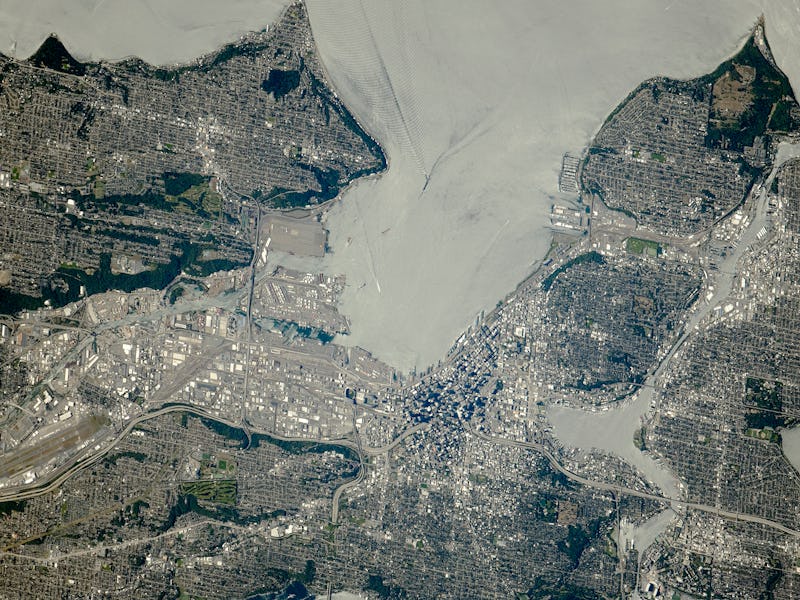The Future of Seattle: Carbon Neutral by 2050?
The Emerald City is the poster child for urban sustainability. But how long will that success last?

Seattle has been a destination for the environmentally minded for two centuries. That eco ethos has flourished even as the source of economic growth has shifted from the region’s forests, to the coastal waters, to the cafes, to giant office parks. It’s remarkable that those values survived the insanely rapid growth of the last half century. Tech companies from Microsoft to Amazon — not to mention Boeing — have made Seattle their home. For the last few years, it has been one of the fastest growing large cities in the U.S.
At the same time, the state’s Growth Management Act and the State Environmental Policy Act have been very effective drivers for sustainable urban development for the longterm. A disproportionate number of architects and urban planners moved in and brought with them (or perhaps, adapted to) the sustainable design movement. As a result, Seattle is in the top 10 cities with the most LEED and Energy Star certified buildings in the country. “That’s a big part of our economy and our culture. It’s manifested itself in our local planning,” says Mark Usen. “This is the place where people come to learn about sustainability.”
Downtown Seattle at night.
That might be why a little over two years ago, the city council voted to adopt a Climate Action Plan that would make Seattle carbon neutral by 2050.
It’s not just talk. One example for how much sustainable design and planning means to Seattle is its participation in 2030 Districts, a nationwide effort to radically transform cities across North America. The Seattle 2030 District plan calls for all existing buildings in the downtown area to do the following things by 2030:
- Reduce energy use by 50 percent
- Reduce carbon emissions by 50 percent
- Manage stormwater peak discharge and potable water use by 50 percent
Under the plan, new buildings would adhere to following standards:
- Immediately use 70 percent less energy than the national median
- Immediately alter stormwater management
- Achieve complete carbon neutrality by 2030
These are, Usen admits, “ambitious goals,” especially when you consider they encompass the entire downtown. But they’re not impossible. Seattle already has “one of the most aggressive energy codes” in the country, says Usen. Close to 90 percent of the city’s electricity is derived from hydroelectricity — comparatively carbon neutral when you stack it against something like coal.
Seattle also runs something called Priority Green, which basically incentivizes developers to build with sustainable elements in order to jump the waiting queue for building permits. “It’s very successful,” says Usen. “It’s an example of how, in a practical sense, how sustainability is being implemented locally.”
But that doesnt mean all sustainability in Seattle needs to have perks attached. Seattle 2030 District is actually non-regulatory. “There’s no actual incentive for it,” says Usen. Yet developers and building owners are still enthusiastically involved with working towards the plan’s goals. “[These parties] are just doing the right thing,” says Usen, probably by encouragement of market pressures.
What does it look like when these buildings actually adopt sustainable design elements? Most experts would probably point to the Bullitt Center: designed to be the greenest commercial building in the world. Classified as a “Living Building” by the International Living Future Institute, the Bullitt Center boasts total carbon neutrality, net positive energy production (thanks to a large solar panel array on the roof), and total independence from the municipal water and sewage system (the building recycles all of its wastewater).
The Bullitt Center across Madison Street, in Seattle, Washington.
“It’s become a major Mecca for sustainabilty junkies like me,” says Usen.
That doesn’t mean it’s going to be all sunshine and flowers from here on out. When asked what problems are on the rise for Seattle, Usen says the city’s biggest challenge is actually its success. One of the consequences of such strong urban growth has been the incredible impact on the affordability of the city, where property values have almost doubled since the Great Recession.
“One of the three tenets of sustainability is social,” says Usen. “From a social equity point of view, the city has become very challenging for people of moderate income levels.”
Urban growth has also turned Seattle into a traffic hell — the fifth most congested city in the U.S. An inadequate transit system means gains made by reducing carbon emissions for buildings is potentially offset by all the cars on the road.
The ferry to Bainbridge Island.
Another growing concern for Seattle is climate change adaptation. The effects of rising temperatures won’t exactly spell doom for Seattle. In fact, some scientists think the Pacific Northwest’s climate will transform into ‘Neo Napa Valley’ — which sounds like a pretty good invitation for people fleeing the disappearing North American coastlines. Influxes of “climate refugees” will likely add a lot more growth pressures to the city.
Hopefully, Seattle will manage to maintain its devotion to sustainable design and planning while potentially becoming one of the country’s largest urban regions. If it does, it could become one the most important 21st century cities in the U.S.